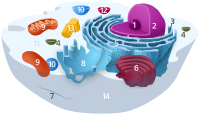
Photo from wikipedia
PEDV infection causes severe piglet mortality and threatens the global pig industry. However, the complex invasion mechanism of PEDV makes its prevention and control difficult. ABSTRACT Porcine epidemic diarrhea virus… Click to show full abstract
PEDV infection causes severe piglet mortality and threatens the global pig industry. However, the complex invasion mechanism of PEDV makes its prevention and control difficult. ABSTRACT Porcine epidemic diarrhea virus (PEDV) has caused huge economic losses to the global pig industry. The swine enteric coronavirus spike (S) protein recognizes various cell surface molecules to regulate viral infection. In this study, we identified 211 host membrane proteins related to the S1 protein by pulldown combined with liquid-chromatography tandem mass spectrometry (LC-MS/MS) analysis. Among these, heat shock protein family A member 5 (HSPA5) was identified through screening as having a specific interaction with the PEDV S protein, and positive regulation of PEDV infection was validated by knockdown and overexpression tests. Further studies verified the role of HSPA5 in viral attachment and internalization. In addition, we found that HSPA5 interacts with S proteins through its nucleotide-binding structural domain (NBD) and that polyclonal antibodies can block viral infection. In detail, HSPA5 was found to be involved in viral trafficking via the endo-/lysosomal pathway. Inhibition of HSPA5 activity during internalization would reduce the subcellular colocalization of PEDV with lysosomes in the endo-/lysosomal pathway. Together, these findings show that HSPA5 is a novel PEDV potential target for the creation of therapeutic drugs. IMPORTANCE PEDV infection causes severe piglet mortality and threatens the global pig industry. However, the complex invasion mechanism of PEDV makes its prevention and control difficult. Here, we determined that HSPA5 is a novel target for PEDV which interacts with its S protein and is involved in viral attachment and internalization, influencing its transport via the endo-/lysosomal pathway. Our work extends knowledge about the relationship between the PEDV S and host proteins and provides a new therapeutic target against PEDV infection.
Journal Title: Journal of Virology
Year Published: 2023
Link to full text (if available)
Share on Social Media: Sign Up to like & get
recommendations!